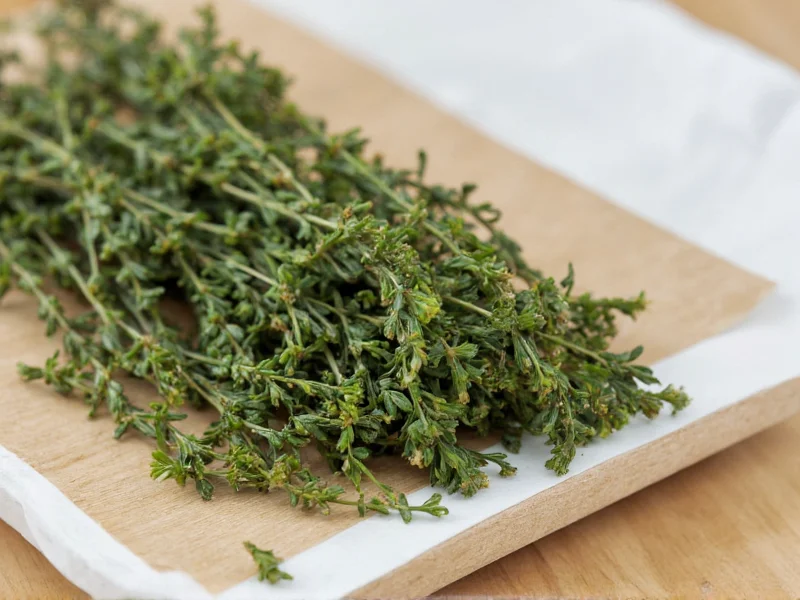Understanding herb substitutions is essential for consistent cooking results, especially when your recipe calls for fresh thyme but you only have dried thyme available. The 1:3 ratio (dried to fresh) isn't arbitrary—it reflects how the drying process concentrates thyme's essential oils and flavor compounds.
Why Dried and Fresh Thyme Aren't Interchangeable 1:1
When thyme leaves are dried, they lose approximately 70-80% of their water content. This concentration means dried thyme delivers more intense flavor in a smaller volume. Using equal measurements would result in an overpowering, potentially bitter dish.
Practical Substitution Guidelines
Follow these specific recommendations for best results in your cooking:
| Recipe Requires | Dried Thyme Substitute | Best Application |
|---|---|---|
| 1 tablespoon fresh thyme | 1 teaspoon dried thyme | Most cooked dishes (soups, stews, roasts) |
| 2 tablespoons fresh thyme | 2 teaspoons dried thyme | Hearty meat dishes, long-simmering sauces |
| 3 tablespoons fresh thyme | 1 tablespoon dried thyme | Robust dishes like braises, chili, tomato sauces |
| 1-2 sprigs fresh thyme | ½-1 teaspoon dried thyme | Delicate dishes, finishing touches |
Adjusting for Different Cooking Methods
The standard dried thyme to fresh thyme conversion works well for most applications, but certain cooking techniques require adjustments:
- Long-cooking dishes (stews, braises): Use ¾ of the recommended dried amount since flavors intensify over time
- Quick-cooking dishes (sauces, sautés): Stick to the standard 1:3 ratio
- Raw applications (salad dressings, garnishes): Dried thyme doesn't work well—seek alternatives like oregano or marjoram
- Baking applications: Reduce dried thyme by 25% as heat concentrates flavors further
Flavor Profile Differences to Consider
Dried thyme has a more earthy, concentrated flavor compared to fresh thyme's bright, grassy notes. When substituting dried for fresh:
- Add dried thyme earlier in the cooking process to allow flavors to mellow
- Consider adding a squeeze of lemon at the end to brighten flavors
- Pair with complementary herbs like rosemary or oregano for balanced flavor
- Always taste and adjust before serving—dried herb potency varies by brand and age
Storage Tips for Maximum Flavor
The effectiveness of your dried thyme substitution depends significantly on how well your dried thyme has been stored:
- Store dried thyme in an airtight container away from light and heat
- Properly stored dried thyme maintains peak flavor for 1-2 years
- Test potency by rubbing and smelling—weak aroma means reduced flavor impact
- Never store dried herbs above the stove where heat degrades quality
Common Substitution Mistakes to Avoid
Even with the correct dried thyme to fresh thyme conversion ratio, these errors can ruin your dish:
- Adding dried herbs too late: They need time to rehydrate and release flavors
- Not adjusting for recipe moisture: In very dry recipes, increase liquid slightly
- Using old, stale dried thyme: Results in weak flavor requiring excessive amounts
- Substituting in raw applications: Dried thyme's texture doesn't work in uncooked dishes
When Fresh Thyme Is Truly Necessary
While dried thyme works well as a substitute in most cooked dishes, certain applications truly require fresh:
- Herb garnishes where visual appeal matters
- Delicate fish preparations where subtle flavors shine
- Certain Middle Eastern and Mediterranean dishes with traditional fresh herb requirements
- When making compound butters or herb oils
Testing Your Substitution Success
The best way to ensure your dried thyme substitute for fresh works in your specific recipe:
- Add 75% of your calculated dried thyme amount initially
- Cook for at least 15 minutes to allow flavors to develop
- Taste and adjust, adding more in small increments
- Remember that flavors continue developing even after cooking stops











 浙公网安备
33010002000092号
浙公网安备
33010002000092号 浙B2-20120091-4
浙B2-20120091-4